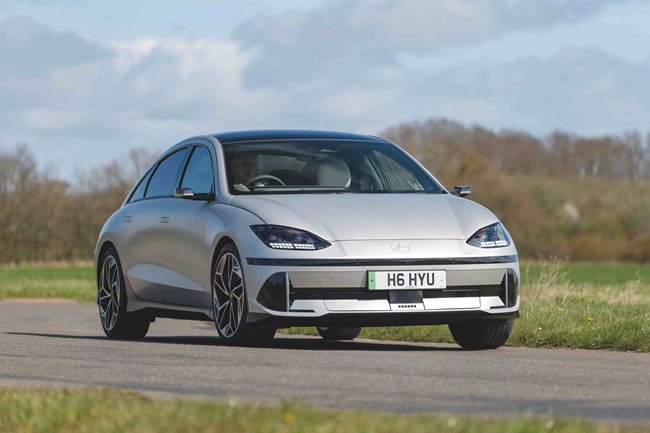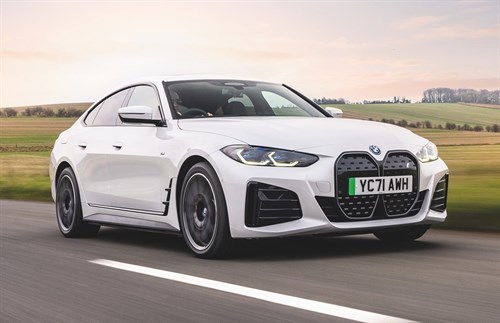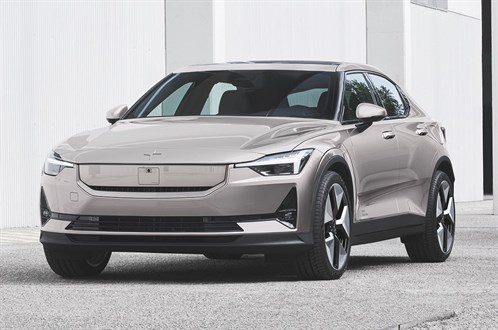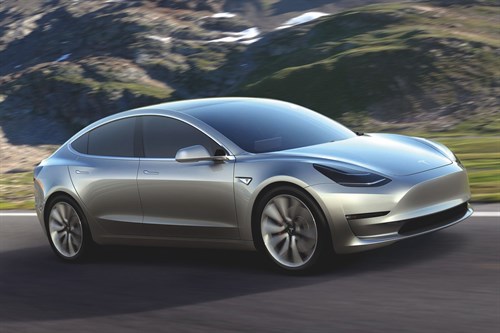We use cookies to ensure that we give you the best experience on our website. If you continue without changing your settings, we will assume that you are happy to receive all cookies on the Business Car website. However, if you would like to, you can change your cookies at any time

The start point for the best source of fleet information |
Best in Class: Mid-size EVs
Date: 11 August 2023 | Author: Martyn Collins

Hyundai Ioniq 6
The Ioniq 6 is attractive and distinctive in equal measure, from the faired-in headlights, deep front air dam with silver edging, to the 6's silhouette, which is lower and more tapered from the side, with flush door handles, to the arch-filling standard 20in alloy wheels.
Most distinctive from the back, its raked style, with not one, but two rear spoilers, a clear light bar stretching across the rear and more silver detailing for the rear apron, means it looks far more exotic than its Hyundai badging would suggest.
Inside, we still wish the driver's seat dropped lower, but the feel is refreshingly different to the Ioniq 5. The only things that have remained the same, are the switchgear and infotainment screens, which are largely in the same place as in the Ioniq 5. Taller passengers might moan about the curvy styling meaning heads will be rubbing the headlining. Still, like the 5, the amount of legroom impresses. The 401-litre boot is a good size and deep, but its practicality is hindered by the high loading lip and smaller opening.
The Ioniq 6 is available in single and twin-motor versions, with the single-motor version we're focussing on here, available in Premium and Ultimate equipment grades. The twin motor version also has a First Edition model. The Hyundai Ioniq 6 Ultimate single motor has a 223hp electric motor, giving a WLTP-calculated range of up to 338 miles. All have the same E-GMP platform as the Ioniq 5, but both have a larger 77kWh battery and standard 800V charging, meaning 350kW ultra-fast charging compatibility and a standard battery heating system to optimise charging times.
All these EV models share the same 2% BIK figure, but the Hyundai finishes in joint first with the Tesla for 20% and 40% monthly figures. But there's just £1 between the joint winners and the BMW and the Polestar in joint second place.
Any EV capable of over 300 miles to a charge is at the top of the fleet car pile in our opinion. The Hyundai boasts a more than respectable 338-mile range, yet the Ioniq 6 is beaten to third place here by the Polestar (367-mile range) and the Tesla (374-mile range). German marques have always tended to perform better than their Korean counterparts, such as the Hyundai, when it comes to residuals. Yet according to our figures from Kee Resources, its 45.23% figure is respectable, but again only good enough for third place and the fact that it's the newest model here isn't enough to secure victory. The Hyundai is pushed into third place behind the Tesla and BMW.
The Ioniq 6 finishes in last place for depreciation, with a £27,632 figure, which is disappointing as it has the most affordable P11D of the group at £50,485. Although the Hyundai does have the lowest SMR costs at £1,999.
Hyundai Ioniq 6 77.4kWh Ultimate
P11D: £50,485
CO2 (tax): 0g/km (2%)
BIK 20/40% a month: £16/£33
Range: 338 miles
National Insurance: £511
First year VED: £0
Subsequent VED: £0
Battery size/power: 77.4kWh/223hp
AFR: 9p
Residual value: 45.23%
Depreciation: £27,652
Fuel costs: £4,201
SMR: £1,999
Cost per mile: 56.42p

BMW i4
Our current favourite electric car over £40,000, the i4 is more conventionally styled, looking like an electric version of the 4 Series Gran Coupe.
Inside, the most distinctive feature is the large, curved display, that's made up of a 14.9in infotainment touchscreen and 12.3in driver display. Legroom in the back of the i4 is more compromised, plus the curved roofline of the fastback shape eats into the available headroom. The i4's hatchback opens to reveal a practically-shaped 470-litre boot.
Price has dictated that we focus on the latest addition to the range - the eDrive35 in most attractive M Sport spec. Still, the 35 combines a 282hp electric motor with rear-wheel drive, giving a WLTP-calculated range of up to 288 miles. It should also be a brilliant drive, just like the rest of the range.
The i4 in this spec, has the second-highest P11D figure at £51,440, and also has the joint highest BIK monthly payments at 20% and 40%, at £17 and £35 with the Polestar. Despite this, the BMW still comes top of the pile, with the highest placings for residual values and depreciation playing their part.
BMW i4 eDrive35 M Sport
P11D: £51,440
CO2 (tax): 0g/km (2%)
BIK 20/40% a month: £17/£35
Range: 288 miles
National Insurance: £521
First year VED: £0
Subsequent VED: £0
Battery size/power: 70.2kWh/288hp
AFR: 9p
Residual value: 58.08%
Depreciation: £21,656
Fuel costs: £4,746
SMR: £2,047
Cost per mile: 48.94p

Polestar 2
Once Polestar was Volvo's performance skunkworks. The Polestar 2 still looks a bit Volvo-like inside and out, but this model has successfully carved a niche as a sportier electric car that works particularly well for fleet. There's the choice of single (now rear drive like sister car the Volvo XC40 Recharge), or dual-motor versions (like we have here), all wrapped up in neat, simple, and recently tweaked styling for the exterior and interior.
The Long Range has electric motors on both the front and rear axles, with 367 miles range, and an impressive 408hp.
All Polestar 2 versions are well-equipped, with standard kit including dual-zone climate control, rain-sensing wipers, heated front seats, a hands-free power tailgate and keyless entry.
The Polestar finishes in third place in terms of P11D (£52,895), with matching BIK payments at 20% and 40% with the winning BMW. Although it has the second-highest SMR figure at £2,662 and second-highest residual value at 54.47%, and is the second-lowest depreciator at £24,801, leading to its solid second position in the group.
Polestar 2 82kWh Long Range
P11D: £52,895
CO2 (tax): 0g/km (2%)
BIK 20/40% a month: £17/£35
Range: 367 miles
National Insurance: £535
First year VED: £0
Subsequent VED: £0
Battery size/power: 82kWh/408hp
AFR: 9p
Residual value: 54.47%
Depreciation: £24,081
Fuel costs: £4,336
SMR: £2,662
Cost per mile: 51.17p

Tesla Model 3
The Model 3 is probably closest in size and concept to the i4 and Ioniq 6, although we believe the BMW has a better ride/handling balance, is more refined and although there are plenty of these on UK roads, the BMW perhaps looks more conventional and attractive than the Tesla in our opinion.
Elsewhere, the Tesla has the most minimalist interior, with everything controlled via the huge 15in central touchscreen. The Model 3's interior is also spacious, plus this Tesla's large windows and glass roof make it feel airy. It is a shame then, that the Tesla doesn't feel as solid or as well-made as any of the other cars here.
The Tesla brand has been one of the key manufacturers to start the current electric car revolution and the Model 3 remains one the best-selling EVs with a price cut making it look even more attractive. However, in this group, it comes in third place, with its 55.87p figure and the Ioniq 6 not far behind. The Tesla has the joint lowest National Insurance figure at £511 and the longest range of the set at 374 miles.
Tesla Model 3 Dual Motor Long Range
P11D: £50,935
CO2 (tax): 0g/km (2%)
BIK 20/40% a month: £16/£33
Range: 374 miles
National Insurance: £515
First year VED: £0
Subsequent VED: £0
Battery size/power: 75kWh/491hp
AFR: 9p
Residual value: 47.39%
Depreciation: £26,796
Fuel costs: £4,036
SMR: £2,692
Cost per mile: 55.87p











